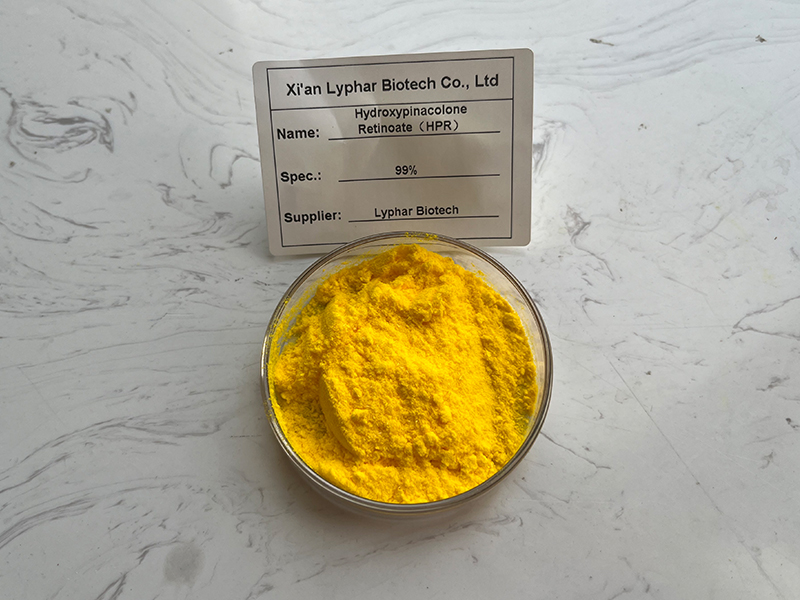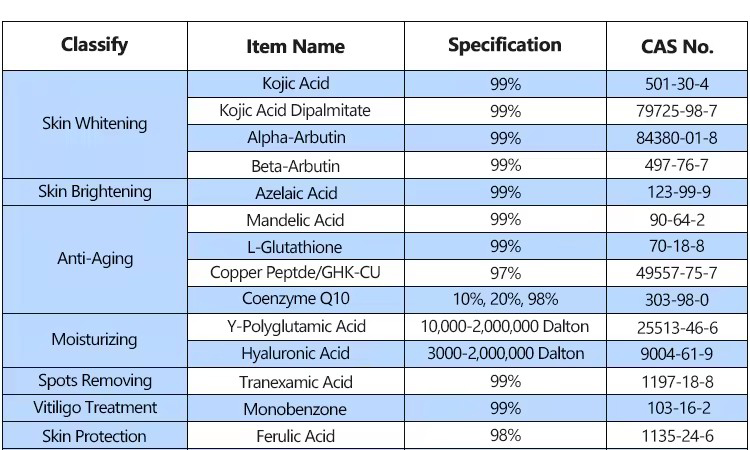Hydroxypinacolone Retinoate (HPR), also known as retinoic acid hydroxypinacolone ester, is a relatively novel ingredient in the skincare industry. It belongs to the family of retinoids, which are derivatives of vitamin A known for their skin-benefiting properties. Here is a comprehensive study on Hydroxypinacolone Retinoate (HPR), covering its chemical properties, mechanism of action, benefits, usage, and safety profile.
Chemical Properties
1.Chemical Structure: Hydroxypinacolone Retinoate (HPR) is an ester of all-trans retinoic acid (also known as tretinoin) and hydroxypinacolone. Its chemical formula is C26H38O3.
2.Molecular Weight: Approximately 398.58 g/mol.
3.Solubility: It is oil-soluble, which facilitates its incorporation into various cosmetic formulations.
Mechanism of Action
Hydroxypinacolone Retinoate (HPR) works similarly to other retinoids by binding to retinoic acid receptors (RARs) in the skin. This interaction influences cellular processes, including:
Cellular Turnover: Promotes the shedding of old skin cells and stimulates the production of new cells, leading to a smoother and more even skin texture.
Collagen Production: Enhances the synthesis of collagen, which helps in reducing the appearance of fine lines and wrinkles.
Regulation of Sebum Production: Can help in reducing acne by regulating sebum production and preventing the clogging of pores.
Unlike other retinoids, Hydroxypinacolone Retinoate (HPR) is noted for its direct action without the need for metabolic conversion to retinoic acid, leading to fewer side effects such as irritation.

Benefits
Anti-Aging: Reduces the appearance of fine lines and wrinkles by stimulating collagen production and promoting cell turnover.
Brightening: Improves skin tone and reduces hyperpigmentation by accelerating the shedding of pigmented cells.
Acne Treatment: Controls acne by regulating sebum production and preventing the formation of comedones.
Skin Texture Improvement: Enhances overall skin texture and smoothness.
Usage
Hydroxypinacolone Retinoate (HPR) is incorporated into various skincare products, including serums, creams, and lotions. It is typically used in concentrations ranging from 0.2% to 1%. Here are some general guidelines for its usage:
Application: Applied once daily, preferably in the evening due to its photosensitivity.
Compatibility: Can be combined with other skincare ingredients like hyaluronic acid, niacinamide, and peptides. However, caution should be taken when used with other potent actives like AHAs and BHAs to avoid irritation.
Sun Protection: It is essential to use sunscreen during the day when using retinoids, including Hydroxypinacolone Retinoate (HPR), to protect the skin from UV damage.
Safety Profile
Hydroxypinacolone Retinoate (HPR) is considered to be a milder and less irritating alternative to other retinoids like tretinoin and retinol. However, some common side effects can still occur, particularly in individuals with sensitive skin:
Irritation: Mild redness, dryness, and peeling may occur initially.
Photosensitivity: Increases the skin’s sensitivity to UV radiation, necessitating the use of sunscreen.
Pregnancy and Lactation: As with other retinoids, HPR should be avoided during pregnancy and lactation due to potential risks to the fetus or infant.
Comparative Advantages
Compared to traditional retinoids, Hydroxypinacolone Retinoate (HPR) offers several advantages:
Lower Irritation: Causes less irritation and dryness, making it suitable for sensitive skin.
Direct Action: Does not require conversion to retinoic acid, leading to more immediate effects.
Stability: More stable than retinol and less prone to degradation when exposed to light and air.

Research and Studies
Several studies have investigated the efficacy and safety of Hydroxypinacolone Retinoate (HPR):
Efficacy in Anti-Aging: Clinical trials have demonstrated significant improvements in fine lines, wrinkles, and overall skin texture with regular use of Hydroxypinacolone Retinoate (HPR)-containing formulations.
Acne Treatment: Studies have shown a reduction in acne lesions and improvement in skin clarity with Hydroxypinacolone Retinoate (HPR).
Comparative Studies: Research comparing Hydroxypinacolone Retinoate (HPR) to retinol and tretinoin indicates that Hydroxypinacolone Retinoate (HPR) offers similar benefits with fewer side effects.
Conclusion
Hydroxypinacolone Retinoate (HPR) is a promising ingredient in the realm of skincare, offering the benefits of retinoids with reduced irritation. Its ability to directly bind to retinoic acid receptors and its stability make it an attractive option for those seeking anti-aging, brightening, and acne treatment benefits. As with all skincare ingredients, it is important to use Hydroxypinacolone Retinoate (HPR) as directed and to incorporate sun protection into the daily routine.
